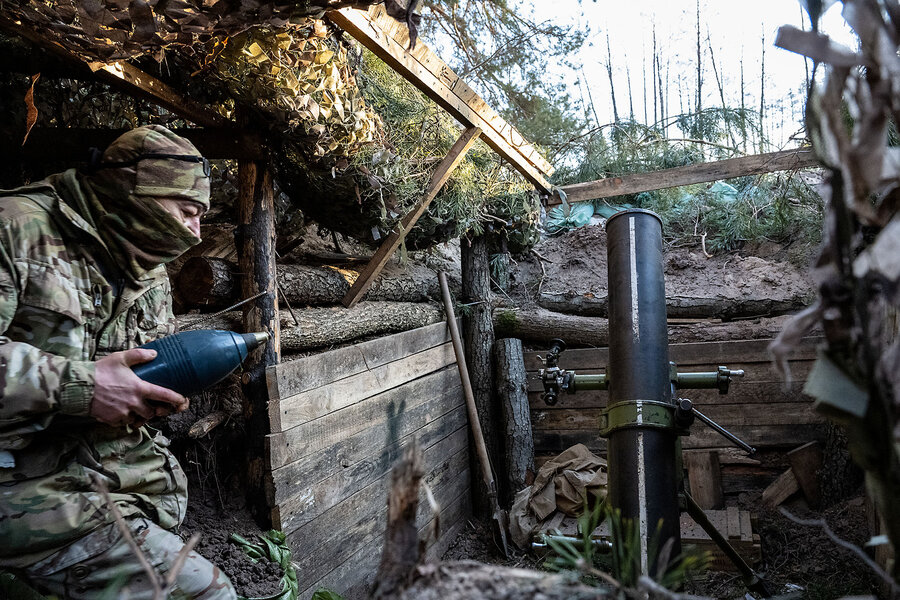Outgunned, Ukrainians watch Congress while facing Russians
| KREMINNA FOREST, Ukraine
The Ukrainian soldiers burrow into their musty underground bunker, waiting at dawn for target coordinates to fire their 105 mm artillery gun. Russian drones have been active overhead, and two incoming Russian shells had come their way.
But the main topic of discussion below ground – here, on one of the farthest frozen battlefields in eastern Ukraine – is of three new jolts of bad news that these soldiers see as closely interlinked. All are indicative of the urgent need for more American arms and ammunition.
First being digested: a new order to substantially cut back and cap the number of shells they fire at the Russian enemy each day.
“Even without this limitation there was not enough,” says the squad leader of the 1st Presidential Brigade of the Ukraine National Guard, giving the name Sasha. “Soon we’re going to have to fight them with our hands.”
Second, news emerged that the city of Avdiivka had fallen, after months of fierce fighting that Ukrainian officials estimate cost Russia some 17,000 dead troops. That news came to this cramped bunker in emotional form, with a video of a wounded soldier left behind in the chaotic final stages of Ukraine’s retreat, who called his sister to say goodbye. (Relatives later recognized the soldier’s body, along with five others, from videos taken after Russians seized the position, Ukrainian media reported.)
The third piece of bad news was from Washington. The U.S. House of Representatives had recessed until the end of February, further delaying a vote on a $60 billion military aid package that cleared the Senate with bipartisan support. Ukraine deems that assistance instrumental to the war effort, if it is going to halt Russia’s building offensive, if not reverse it.
As the second anniversary nears of Russia’s all-out invasion of Ukraine, the optimism that heralded Ukraine’s against-all-odds defense in 2022 – which forced Russian troops away from the capital, Kyiv, and recaptured swaths of northeast and south Ukraine – has faded.
It had diminished throughout 2023 with a failed counteroffensive that was bolstered by Western arms deliveries, yet ran headlong into heavily mined Russian positions.
“You Americans ... have to decide”
But today one message is constant from Ukrainian soldiers, at multiple points along the front: an urgent plea for weapons and ammunition, on a scale and timeline that only the United States can provide.
The $60 billion vote is “very critical. Europe can’t provide all the supplies,” says a soldier in the bunker, a former English teacher who gives the name Kostiantyn.
Ukrainian President Volodymyr Zelenskyy, addressing the loss of Avdiivka and a stepped-up Russian pressure along the front, said Monday that Russia was “taking advantage of the delays in aid to Ukraine.”
“We have enough so we don’t lose, but we are far from getting the means of winning. That’s it,” says Kostiantyn. Like many here, he presents the Ukraine war as a pivotal contest between the democracies of the West, and the authoritarianism and dictatorship represented by Vladimir Putin’s Russia.
“You Americans – ‘We the people,’ as you say – have to decide whether to remain a global power,” the former teacher says. “For us, we don’t have a choice, because we have to fight. If not, then someone on TV will tell my kid she is not Ukrainian, she is Russian. And I don’t want that, so we will keep on fighting.
“For you, you have to decide for yourselves, no matter the camp, Republicans or Democrats,” Kostiantyn says.
“I don’t want you to get the impression that the Ukrainian people are not grateful for all your help and support. You owe us nothing,” he adds. “But the fact remains, if the U.S. and NATO allies want us to win, we need more – we need more for winning.”
And winning is not what is happening for Ukraine on the battlefield today, where soldiers daily fend off dozens of Russian artillery, drone, and ground attacks, and have dug deeper defensive positions all along the front line.
“The worst thing for us is when the guys in the trenches ask for artillery support, because they are getting assaulted, and you just have to answer, ‘We don’t have ammunition,’ and that’s just terrible,” says squad leader Sasha. “Every shell can save some of our guys’ lives there.”
The loss of Avdiivka – a city and Ukrainian front-line bastion since Russia first seized control of nearby Donetsk in 2014 – was the first significant gain for Russia since last May. It was achieved with overwhelming Russian firepower and manpower, despite losses that appear greater than during the Soviet Union’s decadelong 1980s campaign in Afghanistan.
Russia’s “shell advantage”
Oleksander Tarnavskyi, commander of Ukraine’s forces in the south, said in a statement that he had little choice but to withdraw from Avdiivka, citing an enemy “advancing on the corpses of their own soldiers with a 10-to-1 shell advantage, under constant bombardment.”
Indeed, the Russian firepower advantage – and deep Ukrainian need – extends throughout the 600-mile front, where Russian forces fire 10,000 shells a day and have 4,000 artillery pieces in the country, compared with a rationed 2,000 shells a day fired by Ukraine’s 350 artillery pieces, according to an analysis by Jack Watling, a senior research fellow of the Royal United Services Institute.
“In short, without artillery ammunition, the Ukrainians risk being fixed in permanent defense, slowly ceding ground as most recently seen in Avdiivka,” Mr. Watling wrote in Time.
That was the experience of Andrii Rudenko, a combat medic wounded after the Avdiivka withdrawal Monday. He was hit by shrapnel from a grenade dropped by a Russian drone, which had picked up his heat signature while he ran from a position.
On Tuesday, Mr. Rudenko was in a bus full of wounded soldiers being evacuated westward to hospitals far from the front.
“The first point of difference between us and them is the urgent need for artillery,” says Mr. Rudenko. “The Russians can use their mortars again and again to get one man, but we have ammunition hunger.”
As this war nears the start of its third year, he says, “no one is very excitedly running around saying, ‘We are going to go forward and advance.’ We are defending, and everyone understands that we are defending.”
Eye on the House
At another artillery position in the Luhansk region, a few miles from the Russian trenches, a 105 mm howitzer is carefully dug in. The number of shells delivered overnight had dwindled by midmorning.
“If we had 100 rounds, we would have targets for them,” says the commander of the battery, who along with others in the unit asked not to be named. Two Russian artillery rounds land nearby, forcing the soldiers to race to frigid bunkers dug underground.
“Ask Biden, ‘Where are the shells?’” calls out the battery’s gunner.
The commander points to their gun, which remains silent. “If we had more ammo, that would be working now,” he says.
A senior officer approaches a visiting American journalist beside the gun to ask, unbidden and in English: “What is your view of the House of Representatives on Ukraine?”
Wrapped up to keep the cold at bay, the bearded officer is standing amid empty shell casings on the ground, which smell of smoke from the recent firings.
“Of course we watch this [U.S. House vote], because literally our lives depend on this,” says the officer. “If they won’t help us, then we’re done. I can sum it up in one phrase: the more, the better.”
Oleksandr Naselenko supported reporting for this story.






